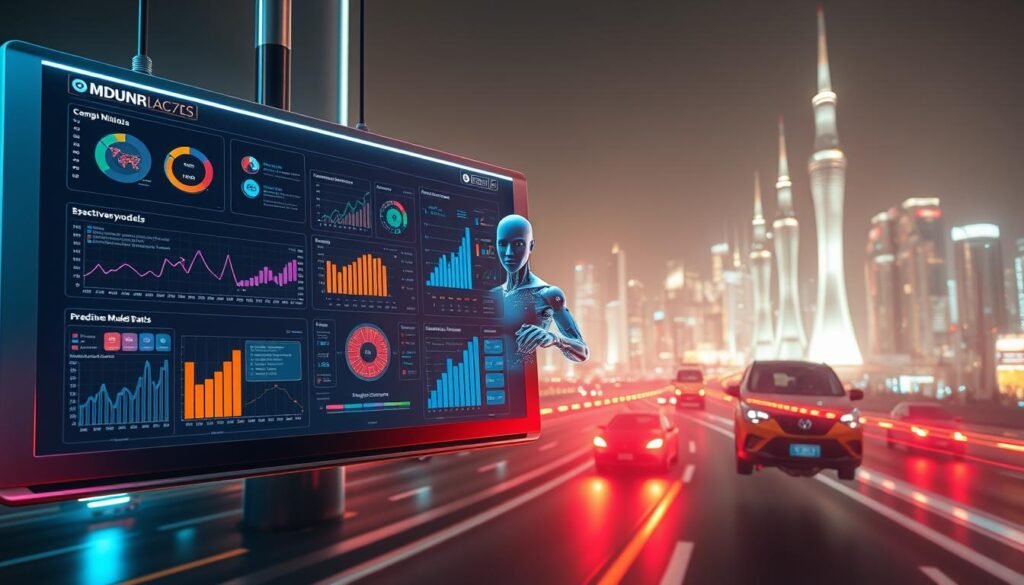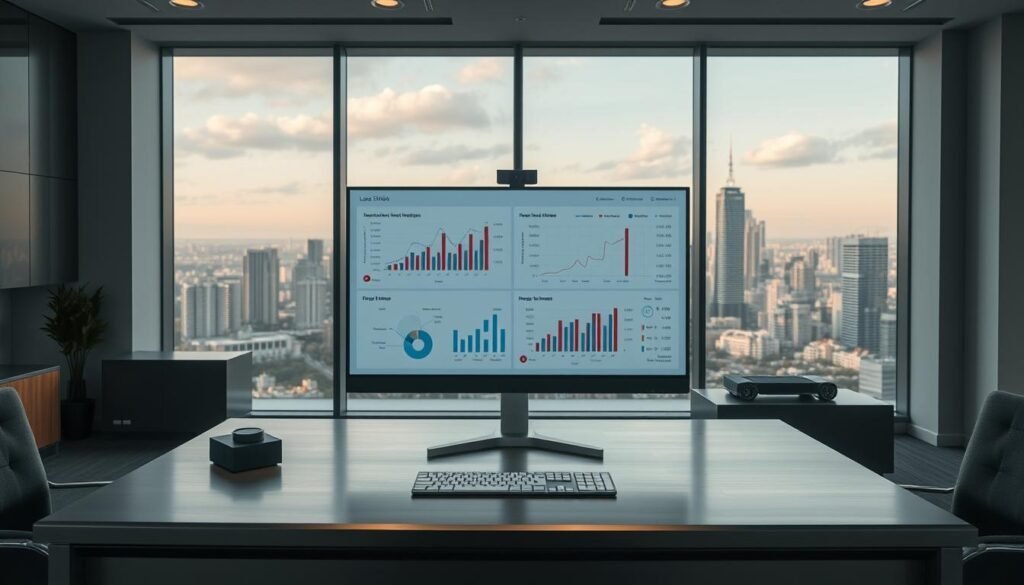Have you ever wondered how top businesses always know what’s coming next? They use predictive analytics to turn data into smart plans. This tool is changing how companies tackle big challenges.
In today’s world, businesses don’t guess anymore. Predictive analytics lets them use smart tools to guess the future. They look at past data to guess what customers will do next. This helps them run better and avoid big problems.
Imagine having a magic tool that gives you exactly what you need. Predictive analytics is like that. It makes data into a plan that helps make big decisions in many areas.
Table of Contents
Key Takeaways
- Predictive analytics transforms raw data into strategic business insights
- Advanced algorithms enable accurate forecasting of market trends
- Businesses can anticipate customer behaviors and optimize operations
- Machine learning techniques provide competitive strategic advantages
- Data-driven decisions reduce risks and improve overall performance
Understanding Predictive Analytics in Modern Business
In today’s fast-changing business world, predictive analytics is a big deal. It helps make better decisions. It turns data into insights that change how companies work and compete.
Predictive analytics is more than just looking at data. It uses smart methods to guess what will happen next. It mixes different areas to make smart guesses for big business choices.
Defining Core Concepts of Data-Driven Predictions
Predictive analytics has a few main parts:
- Statistical modeling
- Machine learning algorithms
- Advanced data mining techniques
- Complex pattern recognition
The Evolution of Predictive Analysis in Decision Making
Businesses used to just react. Now, they can plan ahead. Data-driven decision making lets companies see what’s coming. They can guess market changes, what customers will do, and risks.
Key Components of Predictive Analytics Systems
Good predictive analytics systems have:
- Strong data collection
- Top-notch analytical tools
- Great data science teams
- Integrated tech platforms
By using predictive analytics, companies can turn data into smart plans. This drives new ideas and keeps them ahead in a world that loves data.
The Technical Foundation of Predictive Analytics
Predictive analytics is a complex field. It uses advanced data analysis to turn data into useful insights. This field goes beyond just numbers.
It uses special math and stats to make data useful. This helps us understand and act on data better.
The core of predictive analytics includes several key methods:
- Linear Regression: Helps us see how variables are related
- Logistic Regression: Great for yes or no questions
- Decision Trees: Makes complex choices easy to see
- Neural Networks: Mimics the brain to solve problems
Machine learning has changed how we predict things. It lets businesses make detailed models. These models can see trends, find risks, and spot hidden patterns.
Important parts of predictive analytics are:
- Data getting ready algorithms
- Statistical models
- Machine learning algorithms
- Advanced computer tools
Knowing these basics helps businesses get deep insights. They can make smarter choices.
Also Read: Why is Data Important
Types of Predictive Analytics Models
Predictive modeling helps businesses use data wisely. It turns raw data into useful insights. This is thanks to AI’s power in making predictions.
Predictive analytics has three main types. Each type finds different values in data:
- Classification Models
- Regression Models
- Clustering Models
Classification Models for Data Categorization
Classification models sort data into groups. They are great at making clear differences. For example, I’ve used them to:
- Find customer groups
- Spot fake transactions
- Guess financial risks
Regression Models for Continuous Data Analysis
Regression models are best for studying how things relate. They predict numbers by seeing how factors work together. I’ve used them to forecast:
- Sales and revenue
- How long customers will stay
- Best prices for products
Clustering Models for Pattern Recognition
Clustering models find hidden patterns in data. They group similar data together. This reveals insights that are hard to see with normal analysis. My experience shows they are great for:
- Dividing markets
- Understanding customer behavior
- Finding odd data points
Predictive analytics transforms data into strategic advantage.
Machine Learning and AI in Predictive Analysis

Forecasting with machine learning has changed how businesses look at data. AI makes predictive analytics better by finding patterns fast and right in big data.
AI’s power in making predictions comes from smart algorithms. These algorithms can handle huge amounts of data better than people. This lets companies find secrets in data and make smart choices.
- Machine learning models can analyze historical data to predict future trends
- Neural networks enable complex pattern recognition
- AI algorithms continuously improve prediction accuracy
Machine learning in predictive analysis has big benefits:
- Speed: Quick data processing and analysis
- Accuracy: Fewer mistakes in predictions
- Scalability: Dealing with more complex data
Using advanced machine learning, businesses can turn data into useful information. This gives them an edge in many fields.
Data Collection and Preparation Strategies
To find hidden insights, we need a clear plan for getting and sorting data. Making data ready is key to turning it into useful business info. I’ve learned that careful data collection and prep can really help in data analysis.
Starting to find useful insights means knowing how to manage data well. I’ve made a plan that keeps data quality and trust high during analysis.
Data Mining Techniques
Good data mining uses several important steps:
- Finding the right data sources
- Finding patterns and links
- Using smart algorithms
- Using machine learning
Data Cleaning and Validation Methods
Cleaning data is a big step in getting it ready for analysis. My method includes:
- Getting rid of duplicate data
- Fixing data that’s not the same
- Dealing with missing data wisely
- Making data formats the same
Quality Assurance in Data Processing
To get the most from data analysis, I use strict quality checks. Validation techniques make sure each piece of data is accurate and reliable. This careful work helps us find hidden insights with confidence.
Clean data is the cornerstone of meaningful analysis
With these detailed strategies, companies can turn raw data into valuable business insights. This leads to better decisions and finding insights that were hidden before.
Advantages of Predictive Analytics
Predictive analytics has changed how businesses make big decisions. It offers insights that help them stay ahead of the game.
Companies using predictive analytics see big wins. They understand data in new ways. This helps them make smart choices:
- Enhanced customer targeting through precise behavioral predictions
- Significantly improved customer retention rates
- Proactive fraud detection and risk management
- Streamlined operational efficiency
- Data-driven decision-making capabilities
Predictive analytics is key for making more money. It helps businesses find new ways to earn and improve what they already do.
Predictive analytics transforms raw data into actionable intelligence
Many companies are using predictive analytics to get ahead. It helps them see what’s coming in retail, healthcare, and more.
With advanced tools and data, predictive analytics helps businesses grow and innovate. It’s a smart way to keep improving.
Implementing Predictive Analytics in Business Operations
Proactive business intelligence changes how companies make big decisions. As a data strategy consultant, I’ve seen how predictive analytics helps. It makes operations better by predicting things in many industries.
To use predictive analytics, you need more than just tech. You also need a good plan, careful setup, and everyone on board.
Integration with Existing Systems
Starting well means making systems work together smoothly. Here’s how:
- Check if systems can work together
- Look for any tech problems
- Make special tools for linking systems
- Make sure data moves between systems
Staff Training and Adoption Strategies
It’s important to help employees use predictive analytics well. Here’s what I suggest:
- Make detailed training programs
- Have hands-on workshops
- Keep learning chances open
- Set up mentorship programs
Measuring Implementation Success
To see if it’s working, you need to track things. Key performance indicators should look at:
- How well operations run
- Cost savings
- How good decisions are
- How much money it makes
By using these steps, companies can use predictive analytics to stay ahead and innovate.
Real-Time Analytics and Decision Making

In today’s fast world, making decisions with data is key. Real-time analytics changes how we plan and work. It makes businesses better and more efficient.
Business intelligence helps companies use data right away. This lets them quickly react to market changes. I’ve seen how real-time insights help businesses win.
- Instant data visualization
- Immediate performance tracking
- Dynamic decision-making capabilities
Real-time analytics helps in many areas of business. Critical metrics can now be monitored continuously. This gives leaders the info they need to make smart plans.
Real-time data is no longer a luxury – it’s a necessity for modern businesses seeking to stay ahead of the curve.
Using real-time analytics brings many benefits. These include:
- Faster problem finding
- Being quicker to respond
- Better use of resources
- Less risk in operations
By using data to make decisions, companies can turn information into big wins. This keeps them quick and competitive in a tough business world.
Customer Behavior Prediction and Analysis
Predictive analytics has changed how we understand customers. It uses advanced data analysis to guess what customers will do. This changes how businesses talk to their customers.
These tools do more than just collect data. They help businesses know what customers like, buy, and might do next.
Shopping Pattern Recognition
Seeing what customers buy needs smart analysis. My method includes:
- Tracking what they buy
- Looking at what they browse
- Finding trends by season
- Seeing what else they might like
Customer Lifetime Value Calculation
Figuring out how much a customer is worth helps us focus. Predictive analytics lets us:
- Guess how much money a customer can bring in
- Find out who are the most valuable customers
- Make plans to reach out to them
Churn Prevention Strategies
Predictive analytics helps us stop customers from leaving. Early warning systems spot customers who might leave. This lets us act fast to keep them happy.
Anticipating customer behavior isn’t just about data—it’s about understanding human patterns and needs.
Risk Management Through Predictive Modeling
Predictive modeling has changed how businesses handle risks. It uses advanced data analytics to spot problems before they get big. This way, companies can avoid big issues.
Many businesses see the benefits of predictive modeling. Banks, for example, use it to find fraud and avoid big losses.
- Fraud Detection: Real-time risk assessment
- Financial Loss Prevention: Early warning systems
- Compliance Monitoring: Proactive risk identification
Predictive analytics helps businesses make strong risk plans. They look at past data and find patterns. This helps protect their money and good name.
| Risk Type | Predictive Strategy | Potential Impact Reduction |
|---|---|---|
| Financial Fraud | Advanced Pattern Recognition | Up to 75% |
| Operational Risks | Predictive Maintenance | Up to 60% |
| Credit Risk | Behavioral Analysis | Up to 65% |
Predictive modeling is more than just avoiding bad things. It’s a smart way to turn risks into chances for growth and new ideas. By knowing about problems before they start, businesses can make better choices and stay ahead.
Optimizing Operations with Predictive Insights
Predictive analytics has changed how businesses work. It uses data to help companies make better choices. This leads to smarter ways of doing things.
Using predictions to improve operations is very helpful. It gives businesses a way to understand and better their main activities. Predictive analytics does more than just look at data. It helps businesses perform better in many ways.
Strategic Supply Chain Management
In supply chain management, predictive analytics helps a lot. It lets businesses:
- Guess how much inventory they need with great accuracy
- See problems before they happen
- Find the best ways to ship things
- Save money by cutting down on waste
Resource Allocation Improvements
Predictive models help businesses use their resources better. They give managers:
- Info on assets that aren’t being used
- Ways to use workers better
- Clues on what skills they’ll need later
- Ways to meet needs without spending too much
Process Efficiency Enhancement
Predictive analytics makes operations better by giving insights in real time. It helps companies make their work flows smoother. They can avoid delays and work faster.
Data is the new oil, and predictive analytics is the refinery that turns raw information into strategic advantage.
By using these advanced tools, businesses can do much better. They can get ahead of the competition.
Financial Forecasting and Planning
Predictive analytics has changed how I plan finances. It uses machine learning for better forecasting. This helps me make smarter financial choices.
My financial plans now use advanced predictive models. These models look at complex data. They help me:
- Predict revenue streams with greater accuracy
- Identify financial risks
- Optimize budget allocation
- Develop responsive financial strategies
Predictive analytics does more than just numbers. It uses advanced machine learning for real-time forecasts. This lets me act before problems arise.
Data is the new currency of financial planning, and machine learning is the key to unlocking its true value.
Dynamic financial models are a big plus. They look at many factors, like past performance and current trends. This gives a full picture of what might happen financially.
- Less financial uncertainty
- More accurate budget planning
- Better strategic decisions
Using data for decisions has been a big win. Machine learning insights help me face financial challenges and find new chances.
Industry-Specific Applications and Case Studies
Predictive analytics changes how businesses make decisions. It shows real benefits in many areas.
I’ve seen big changes in many fields. Predictive analytics helps solve unique problems.
Healthcare Analytics Revolution
In healthcare, predictive analytics helps a lot. It makes patient care better. Hospitals use it to:
- Predict disease outbreaks
- Make better treatment plans
- Lower hospital readmission rates
- Give personalized care
Retail Industry Transformation
Retail uses predictive analytics to know customers better. It helps make shopping better. Key uses are:
- Personalized product suggestions
- Changing prices to fit demand
- Managing inventory better
- Keeping customers from leaving
Manufacturing Sector Innovations
Manufacturing gets better with predictive analytics. It helps a lot. Key uses are:
- Knowing when to fix equipment
- Improving quality control
- Managing supply chain risks
- Making production flow better
Predictive analytics turns data into big advantages for businesses.
Using data in this way, companies get new insights and ways to work better.
Future Trends in Predictive Analytics
Predictive analytics is changing fast. New things in artificial intelligence and machine learning are leading the way. Using AI for predictions is key for businesses to stay ahead in a world full of data.
Machine learning is getting better at forecasting. It’s using new ways to look at data and give better insights. Here are some big changes coming to predictive analytics:
- Enhanced AI-driven decision-making algorithms
- Real-time predictive modeling capabilities
- Increased integration of edge computing technologies
- Advanced neural network architectures
New tech is making predictions more accurate. Machine learning algorithms are becoming more adaptive. They can learn and get better on their own, with little help from people.
| Trend | Potential Impact | Industry Relevance |
|---|---|---|
| Autonomous AI Predictions | 90% accuracy improvement | Finance, Healthcare, Retail |
| Quantum Machine Learning | Complex problem solving | Research, Technology |
| Explainable AI Models | Enhanced transparency | Regulatory Compliance |
Companies that use these new technologies will lead in data-driven innovation. They will get new insights and strategic advantages.
Challenges and Solutions in Implementation
Starting predictive analytics can be tough. It can stop you from making smart decisions with data. Many groups face big hurdles that need smart plans to beat.
The main problems with starting predictive analytics are in three big areas:
- Data Quality and Integration
- Skill Gap and Technical Expertise
- Organizational Culture Transformation
Getting good data is the biggest challenge. Bad data can make predictive analytics not work well. Companies need to work hard on cleaning and checking data to get right answers.
| Challenge | Impact | Potential Solution |
|---|---|---|
| Poor Data Quality | Inaccurate Predictions | Comprehensive Data Governance |
| Skills Shortage | Limited Analytics Capability | Training and Recruitment |
| Cultural Resistance | Slow Adoption | Change Management Programs |
Having a good team is key for predictive analytics to work. You need data scientists and keep training them. Also, make sure everyone values making decisions with data.
My experience shows that culture matters a lot. Leaders should lead by example, showing how predictive analytics helps all parts of the business.
Successful predictive analytics is less about technology and more about strategic thinking and organizational alignment.
By tackling these problems head-on, companies can really use predictive analytics. This can change how they make big decisions.
Conclusion
I’ve learned a lot about predictive analytics. It’s amazing how it can find hidden insights in data. It’s not just about numbers anymore.
Now, businesses can see what’s coming in the market. They can understand what their customers want. And they can make better choices.
Using predictive analytics, companies can get ahead of their rivals. They can spot problems early and fix things before they get worse. It’s like having a superpower for your business.
I think all business leaders should use predictive analytics. It can change how things work in many fields. It’s not just for tech companies anymore.
Businesses that use data well will do great things. They can make things better for their customers and make smarter choices. Start using predictive analytics today and see how it can help your business.
FAQ
What is predictive analytics?
Predictive analytics uses old data and smart algorithms to guess what will happen next. It’s like a magic tool for business, helping us see what might happen and make better choices.
How can predictive analytics benefit my business?
Predictive analytics helps in many ways. It makes it easier to find the right customers, work more efficiently, and make safer choices. It can also help your business grow and stay ahead of the competition.
What types of predictive analytics models exist?
There are three main types of models. Classification models sort data, regression models analyze numbers, and clustering models find patterns. Each helps businesses understand and predict data in different ways.
How accurate are predictive analytics predictions?
Predictions can be very accurate if the data is good and the models are smart. I’ve seen it work well when using advanced techniques and keeping data clean.
Do I need advanced technical skills to use predictive analytics?
You don’t need to be a tech expert to use it. Many tools make predictive analytics easy for businesses of all sizes. With the right training, teams can use it without being data science experts.
What industries can benefit from predictive analytics?
Almost every industry can use predictive analytics. I’ve seen it work well in healthcare, retail, and more. The key is finding the right use cases for your business.
What are the biggest challenges in implementing predictive analytics?
The biggest challenges are making sure the data is good, building a team, choosing the right tech, and creating a data culture. Overcoming these needs planning, learning, and a commitment to getting better.
How does machine learning enhance predictive analytics?
Machine learning makes predictive analytics better by learning from data and getting smarter over time. I’ve seen it make predictions more accurate and find insights that old methods miss.
What kind of data is needed for effective predictive analytics?
Good predictive analytics needs diverse, high-quality data from many places. This includes business history, customer info, and market trends. Collecting the right data is key for the best insights.
How quickly can I see results from predictive analytics?
Results can come quickly, but the biggest benefits come from ongoing work. I’ve seen businesses get initial insights in weeks. But, the real value comes from keeping at it and managing data well over time.














